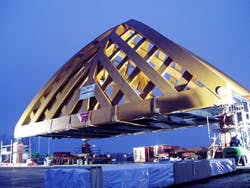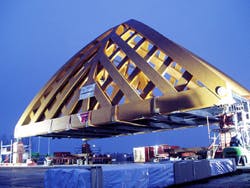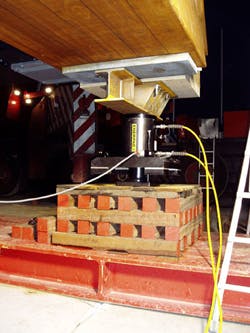Web Exclusive - Synchronous Lift System raises the bridge
At the end of November 2008, a 360 ton wooden bridge was positioned over the A7 national trunk road near Akkerwinde in Sneek (the Netherlands), completing the first phase of a unique project. Prior to being transported with SMTPs from the nearby assembly site to its destination, the whole bridge construction was lifted to a height of more than 5 m using Enerpac's hydraulic computer-controlled Synchronous Lift System.
This bridge project consists of building two wooden bridges over the new southern A7 ring road. Both bridges — which are actually viaducts — form "landmarks" or recognizable features of the town. As part of the first phase, a new bridge was placed in the Akkerwinde location at the end of November. The second bridge is planned for the Molenkrite area.
A new one for the ages
The new bridge consists of a steel deck and two vertical, wooden arches that are 32 m long and 16 m high, Figure 1. Bolts and legs join the arches together. This is the first wooden bridge ever to be constructed anywhere in the world in this size and for all forms of traffic. The bridges are an example of progressive architecture, of which the term "durability" is an important element, alongside aesthetic and structural criteria. This applies to both the materials used and the lifespan.
What makes the bridge unique is the wooden arches and their use. Whilst there are already a few modern wooden bridges in the world, none of them until now have been built to such a scale and to support all traffic.
Laminated cribbing blocks made of Accoya wood measuring 1080 x 1400 mm were used for the arches. This type of wood comes from production forests in New Zealand and is produced and supplied by the Dutch company Titan Wood. Following the process of acetylation, the wood naturally absorbs less moisture, therefore increasing its durability. The German manufacturer Schaffitzel guarantees a lifespan of 80 years for this wood, as long as it is properly maintained.
Figure 1. The wooden Akkerwinde bridge, which weighs 360 ton, was lifted more than five metres using Enerpac's digital Synchronous Lift System to position it correctly.
Digital lifting
The new bridge's deck and arches were mounted on an assembly site around 11/2 km away from the bridge's current location over the A7. After assembly, the bridge was lifted to the correct height for its final position, using Enerpac's computer-controlled hydraulic Synchronous Lift System. According to project leader Michel de Jong of Wagenborg Nedlift, "The system works perfectly. We have already used it a number of times, but what was unique about this project was that we had to lift the bottom of the bridge up to 5.10 m, whereas the lift system's highest prop was 4.40 m."
Thanks to its digital and synchronous lifting technology, this Enerpac hydraulic system not only saves a considerable amount of time, but also is highly accurate, meaning the lifting process can be perfectly balanced, monitored, and managed.
Four abutments
The Enerpac Synchronous Lift System is a combination of digital control, switching, and monitoring. Thanks to specific software, lifting (and lowering) is extremely accurate; the lift system can lift even the heaviest loads with a controlled accuracy of 1 mm.
Only four abutments with BLS Stage-Lift double-acting cylinders (one under each corner of the bridge) were needed to lift up the special massive bridge. The BLS cylinders are intended for the "Lift and Crib" system and have integrated supports to make it easier to position underlying padding materials.
The four lift cylinders, with a total capacity of 1000 ton, were placed on hardwood outer cribbing blocks, which were stacked diagonally layer for layer. A new layer of outer cribbing blocks was put down after around each 10 cm of lifting, as seen in Figure 2.
Each cylinder was connected to its own hydraulic pump unit, which was controlled by computer using sensors placed right next to the lift cylinders. The computer program controlled the cylinder movements, independently of the measurements, by switching the hydraulic directional control valves. During this control, short impulses are sent to the valves in fractions of a second, so that individual cylinder movements are kept much smaller than is possible using manual control.
Not only does the Wagenborg Nedlift system save a considerable amount of time compared to manual lifting, but it also has a very essential advantage: thanks to the synchronous and therefore perfectly balanced lifting, virtually no internal stresses arise within the load. Michel de Jong concludes, "We chose Enerpac because it is a company that operates internationally, but more importantly because of the accuracy of its system. The Synchronous Lift System allows us to perfectly manage and monitor the whole operation. And the data saved can be considered afterwards, together with the customer, to evaluate how things went. And with this project, everything went as we wanted it to."
Email [email protected] or visit www.enerpac.com for more information.


